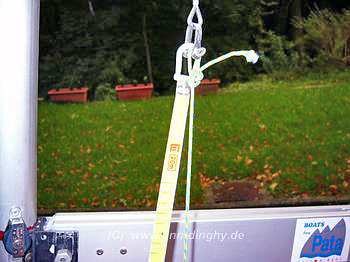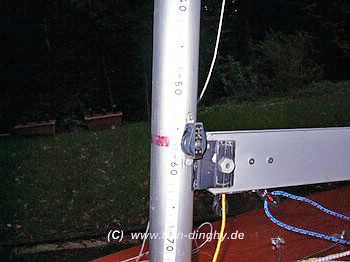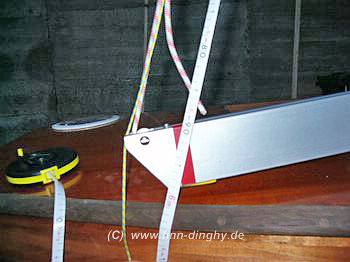Unter Mastfall verstehen wir in der Finn-Klasse die nach achtern gerichtete Neigung des Mastes.
Früher mass man die Entfernung von der oberen Messmarke des Mastes bis zur oberen Kante des Hecks (Spiegels).
Bei Alumasten galt 6,78 m als Standardwert. (Fifi fuhr mit 6,73)
-------------------------------------------------------------------------------------
Bei Finns mit verstellbarem Decksring wird statt eines Längenwertes die Achterliekspannung gemessen.
Wir benötigen dazu:
1 Bandmass (min. 6 m lang)
1 Eine Zugwaage ( 30.. 40 kg)
1 Spekta-Seil (3... 4 mm, ca. 6 m lang)
1. Kalibrieren unseres Bandmasses

Wir befestigen Bandmass und Spectra-Seil am Grossfall, ziehen beide Teile nach oben und lassen das Grossfall einrasten.

Nun halten wir das Bandmass an die unten am Mast (!) befindliche Messmarke und lesen den Wert ab.
Beträgt der abgelesene Wert 5,70 m ist alles in Ordnung.
Ist der abgelesene Wert grösser oder kleiner, so merken wir und die "Differenz".
Auf dem Foto beträgt der Ablesewert 5,58 m, da das Bandmass oben 12 cm Vorlauf hat. Die "Differenz" beträgt also - 12 cm.
2. Einstellen der Achterliekslänge (6,02 m)

Wir befestigen jetzt das freie Ende des Spectra-Seils am Outhaul (Baumnock) und stellen das Outhaul so ein, dass sich für unser parallel zum Spectra-Seil verlaufendes Bandmass an der achteren Messmarke des Baumes ein Wert von 6,02 m plus oder minus der "Differenz" (siehe 1.) ergibt.
(6,02 m entprechen der maximal erlaubten Länge des Achterlieks eines Finnsegels.)
Beispiel: Haben wir am Mast statt 5,70 m 5,58 m abgelesen, müssen wir von der Achterliekslänge 12 cm abziehen, d.h. statt 6,02 dann 5,90 m einstellen.
3. Messen der Achterlieksspannung
Neue Methode - Finnsailing RSA
Measure from the front of mast ring on the mast to the extended bow line on deck level. This should be between 630mm and 645mm
Hoist the halliard, connected to a tape measure to the position in which you lock your main sail when hoisting it. Measure to the middle transom edge of your boat – 6720mm (can vary – but proposed measurement)
Sheet in your mainsheet and lock it down with boom onto the deck in the centre. Now measure the length to the black band on the end of your boom which should read 6020mm.
To “split hairs” one can measure the leech of the sail and use that measurement.
The following is a guide.
A strong, fit heavy skipper like Adrian Brunton uses 33.2 kg. Alan Burrel 33kg. Lighter skippers use 30.5kg to 31kg, and really light helmsmen have been known to use less than 27kg.
Siehe https://www.facebook.com/finnsailingza/ ... 8387917270
[Kommentar: Die angegebenen Werte sind weniger das Ergebnis einer zielgerichteten Masteinstellung, sondern ergeben sich aufgrund der unterschiedlichen Härte der verwendeten Masten. Es macht also keinen Sinn, einen weichen Mast auf bsw. 33kg trimmen zu wollen, da das Segel dann am Wind aufgrund der starken Mastkrümmung zu flach wäre.]
[Zusatz-Kommentar: Raudaschl Nautic schreibt in der Finn-Trimmbeschreibung: AL-Spannung ... muss immer mit dem Mastfall gemessen werden. Als Grundregel gilt hier 30 - 33 kg bei einem Mastfall von 6.730 mm (+/- 20 mm.]
Alte Methode - IFA Finn Clinic 2003
Wir ziehen den Baum mit Hilfe der Schot an Deck (Baumnock ausserhalb der Scheuerleiste, 1cm Abstand zwischen Baum und Deck) und messen mit Hilfe der Zugwaage die Achterliekspannung (31-37 kp).
34 kp ist ein mittlerer Wert für gut trainierte Finnrecken mit 100 kg.
30-31 kg ist ein mittlerer Wert für Hobbysegler
(Trimmtip v. Ian Ainslie - Finnfare - Oct. 1997:
"Schräg für Leichtwind, aufrecht für Mittel- und Starkwind, und wiederum schräg für Kuhsturm.")
Also z.B. 33 kp für Leichtwind, 35 kp für Mittel- und Starkwind, 33 kp oder weniger für Kuhsturm.
Bei Leichtwind errreichen wir durch strkere Neigung des Mastes eine gewisse Luvgierigkeit, die es uns erleichtert, stets maximale Höhe zu fahren.
Bei etwas mehr Wind stellen wir den Mast etwas aufrechter, da die Luvgierigkeit durch Krängung des Bootes erreicht wird.
Bei Kuhsturm fahren wir wieder mit mehr Mastfall, um das Achterliek zu öffnen und Druck aus dem Segel zu nehmen.
-

